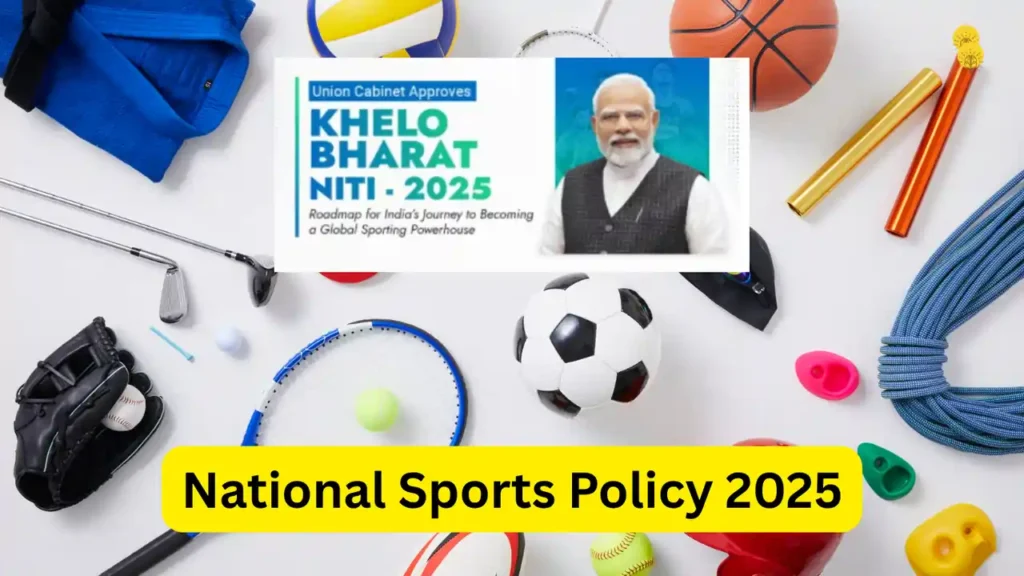New Delhi : On July 1, 2025, the Union Cabinet, chaired by Prime Minister Narendra Modi, approved the National Sports Policy (NSP) 2025, officially termed Khelo Bharat Niti 2025, marking a historic milestone in India’s journey to become a global sporting powerhouse. This transformative policy replaces the outdated National Sports Policy of 2001, which had been in place for over two decades. The NSP 2025 is designed to reshape India’s sporting landscape, empower citizens through sports, and position the nation as a strong contender for hosting and excelling at the 2036 Olympic Games. This comprehensive policy is built on five key pillars: Excellence on the Global Stage, Sports for Economic Development, Sports for Social Development, Sports as a People’s Movement, and Integration with Education (NEP 2020).

A Vision Rooted in Five Pillars
The NSP 2025, or Khelo Bharat Niti, is a masterplan that touches every aspect of sports, from grassroots participation to elite performance. Its five pillars create a seamless vision that blends global aspirations with local impact, ensuring sports become a way of life for every Indian. The policy is the outcome of extensive consultations involving Central Ministries, NITI Aayog, State Governments, National Sports Federations (NSFs), athletes, domain experts, and public stakeholders, reflecting India’s collective aspirations.
1. Excellence on the Global Stage
The first pillar focuses on establishing India as a dominant force in international sports. The policy outlines a clear path to nurture talent from an early age, equipping athletes with world-class coaching, sports science, and cutting-edge technology. Key initiatives include early talent identification, building competitive leagues, and expanding sports infrastructure in both rural and urban areas. The policy emphasizes strengthening the governance and capacity of National Sports Federations to ensure transparency and efficiency.
To enhance athlete support systems, the NSP 2025 promotes the recruitment and training of high-quality coaches, both domestic and international. It also focuses on athlete monitoring systems for injury prevention, recovery, nutrition, psychology, and long-term health. The policy encourages Indian-origin athletes living abroad to represent India at international events, fostering a sense of national pride and global competitiveness. With India eyeing the 2036 Olympics as a potential host, this pillar is a call to action for the nation to not just participate but shine on the global stage.
2. Sports for Economic Development
Recognizing the vast economic potential of sports, the NSP 2025 aims to transform the sector into a major contributor to India’s growth. The policy promotes sports tourism, international event hosting, and the development of a robust sports manufacturing and startup ecosystem. By attracting global events, such as the 2036 Olympics, India aims to boost its tourism sector, create jobs, and stimulate local economies. The policy envisions stadiums buzzing with tourists, local businesses thriving, and India emerging as a go-to destination for international sporting events.
To achieve this, the government will collaborate with private companies through Public-Private Partnerships (PPPs) and Corporate Social Responsibility (CSR) initiatives. Innovative financing mechanisms will make private sector involvement in sports development attractive and sustainable, incorporating Return on Investment (ROI) considerations. The policy also proposes developing a robust sports equipment manufacturing sector and fostering a thriving environment for sports startups and entrepreneurs through various programs and schemes. Additionally, the government plans to establish 13 new professional sports leagues in cities across the country, enhancing event planning and infrastructure.
3. Sports for Social Development
The third pillar harnesses the power of sports to drive social change and foster inclusivity. The policy ensures that everyone, especially underrepresented groups such as women, tribal communities, economically weaker sections, persons with disabilities, and the LGBTQ+ community, gets a chance to participate in sports. By promoting social inclusion, the NSP 2025 aims to break barriers, foster social cohesion, and build a healthier, more connected India.
The policy also focuses on reviving indigenous and traditional games, blending cultural pride with modern aspirations. It supports dual-career pathways, allowing athletes to pursue education alongside their sporting ambitions. Additionally, the policy engages the Indian diaspora, encouraging them to represent India at international events, further strengthening national unity and global presence. Through these efforts, sports will tell stories of resilience and unity across the nation.
4. Sports as a People’s Movement
The fourth pillar aims to ignite a nationwide passion for sports, transforming it into a people’s movement. The policy encourages mass participation through community events such as walkathons, marathons, yoga sessions, and cycling rallies. It seeks to make sports facilities accessible to everyone, not just elite athletes, by expanding infrastructure in rural and urban areas. Nationwide campaigns will promote a culture of fitness, introducing fitness indices in schools and workplaces to encourage active lifestyles.
Supported by volunteers and the Indian diaspora, this pillar envisions schools, workplaces, and neighborhoods pulsing with sports activities. The goal is to build a healthy and active society where families play together, communities rally around local tournaments, and every Indian embraces fitness as a way of life. This movement is not just about athletes but about creating a nation that values physical activity and well-being.
5. Integration with Education (NEP 2020)
The fifth pillar aligns the NSP 2025 with the National Education Policy (NEP) 2020, emphasizing the integration of sports into school curricula. By making sports as important as academics, arts, and other skills, the policy ensures that every student gets a chance to play, stay fit, and grow through sports. Specialized training for physical education teachers will promote sports education and awareness, fostering discipline, teamwork, and ambition among students.
This integration creates dual pathways where students can pursue academic and athletic goals simultaneously, making sports a viable career path. By embedding sports in the education system, the policy ensures that the next generation sees sports not as an extracurricular activity but as a cornerstone of holistic development. This approach aligns with the broader vision of creating healthier, more engaged, and empowered citizens.
A Decade of Building the Foundation
The Khelo Bharat Niti builds on the Modi government’s unwavering commitment to sports over the past 11 years. Since 2014, initiatives like Khelo India, launched in 2018, have been game-changers, identifying and nurturing young talent through grassroots programs, playfield development, and community coaching. Khelo India has provided opportunities to rural youth, women, and persons with disabilities, ensuring that talent knows no boundaries.
The government has invested heavily in world-class infrastructure, including National Centres of Excellence (NCOEs) under the Sports Authority of India (SAI), established in 1984 under the Societies Act, 1860. State-of-the-art equipment, such as archery gear and weightlifting facilities, has been introduced, particularly in rural areas, democratizing access to training. Union Minister Ashwini Vaishnaw highlighted this ethos, stating, “The PM has given a different kind of emphasis to sports, especially in rural areas.” Sports Minister Mansukh Mandaviya’s efforts to involve companies in adopting Olympic sports and promoting leagues further signal a forward-thinking approach to professionalizing sports management.
Other government schemes, such as the Target Olympic Podium Scheme (TOPS) launched in 2014 and the Fit India Movement initiated in 2019, have complemented these efforts. These initiatives have laid a solid foundation, and the NSP 2025 is poised to take India’s sporting ecosystem to the next level.
Strategic Framework and Implementation
The NSP 2025 outlines a robust implementation strategy to ensure accountability and progress. A national monitoring framework with defined performance benchmarks and timelines will track the policy’s success. The “whole-of-government” approach integrates sports promotion across various departments and schemes, encouraging states and union territories to align their sports policies with national goals.
To modernize governance, the policy proposes a robust regulatory framework, including a potential National Sports Governance Bill to restructure sports federations and streamline administration. Emerging technologies, such as AI and data analytics, will be leveraged to enhance performance and decision-making. A national-level monitoring framework will ensure transparency and efficiency in the execution of funded activities.
India’s Olympic Ambitions
The NSP 2025 positions India as a strong contender for hosting the 2036 Olympic and Paralympic Games in Ahmedabad. On July 1, 2025, a high-level Indian delegation, including IOA president PT Usha, Gujarat sports minister Harsh Sanghavi, and senior officials, engaged in a “continuous dialogue process” with the International Olympic Committee (IOC) in Lausanne. The discussions provided a platform to articulate India’s vision for hosting the Olympics and gain insights into the IOC’s requirements.
The policy aims to create an inclusive and robust sporting ecosystem that nurtures talent from the grassroots to the Olympic podium. By attracting international participants and spectators, India can significantly boost its tourism sector, create jobs, and enhance its global image. The focus on hosting major international tournaments will generate substantial revenue and establish India as a global sports tourism hub.
Voices of Support
Piyush Rai, National Sports Head at Orchids The International School, welcomed the policy, stating, “The National Sports Policy 2025 is a timely and much-needed shift in India’s approach to athletic development. By emphasizing grassroots participation, infrastructure, and integration of sports into the education system, the policy lays the foundation for a more inclusive and performance-driven sporting culture. What excites me most is the focus on long-term athlete development and evidence-based training frameworks. If implemented effectively, this policy could be a game-changer for every child in India who dreams of making it big in sports.”
A New Dawn for Indian Sports
The Khelo Bharat Niti 2025 is more than a policy—it’s a clarion call to transform India into a global sporting powerhouse. Its five pillars weave together excellence, economic growth, social inclusion, mass participation, and education, creating a holistic vision for sports. Building on the Modi government’s decade-long legacy of infrastructure development and talent nurturing, the policy sets India on a trajectory to rank among the top five sporting nations by 2047.
From nurturing world-class athletes to fostering a culture of fitness, the NSP 2025 is a bold blueprint to make sports a way of life for every Indian. As Prime Minister Modi declared on X, “Today is a landmark day for India’s efforts to encourage sporting talent and become a hub for sports! May Indian sporting talent always flourish!” With this visionary policy, India is not just chasing medals—it’s chasing a legacy of unity, pride, and global leadership in sports.
Frequently Asked Questions (FAQs)
1. What is the National Sports Policy (NSP) 2025, and how does it differ from the previous policy?
The NSP 2025, also known as Khelo Bharat Niti, is a comprehensive framework approved by the Union Cabinet on July 1, 2025, aimed at transforming India’s sporting ecosystem. It replaces the National Sports Policy of 2001, which had been in place for over two decades. Unlike its predecessor, NSP 2025 is built on five key pillars—Excellence on the Global Stage, Sports for Economic Development, Sports for Social Development, Sports as a People’s Movement, and Integration with Education (NEP 2020)—and focuses on modernizing governance, leveraging technology, and positioning India as a global sporting powerhouse, with a specific goal of hosting and excelling at the 2036 Olympics.
2. What are the five pillars of the NSP 2025, and what do they aim to achieve?
The NSP 2025 is anchored on five pillars:
Integration with Education (NEP 2020): Embeds sports in school curricula, provides specialized training for educators, and supports dual-career pathways for students to balance academics and athletics.
Excellence on the Global Stage: Focuses on nurturing world-class athletes through early talent identification, competitive leagues, and advanced coaching, sports science, and technology, aiming to make India a dominant force in international sports.
Sports for Economic Development: Promotes sports tourism, event hosting, and a sports manufacturing and startup ecosystem to boost job creation and economic growth.
Sports for Social Development: Ensures inclusivity by increasing participation among women, tribal communities, economically weaker sections, and persons with disabilities, while reviving indigenous games.
Sports as a People’s Movement: Encourages mass participation through community events and accessible sports facilities to foster a culture of fitness nationwide.
3. How does the NSP 2025 plan to support India’s bid to host the 2036 Olympics?
The NSP 2025 positions India as a strong contender for hosting the 2036 Olympic and Paralympic Games in Ahmedabad. It emphasizes building world-class infrastructure, enhancing event planning, and establishing professional sports leagues to attract international events. The policy also encourages private sector partnerships through Public-Private Partnerships (PPPs) and Corporate Social Responsibility (CSR) initiatives to fund and manage top-quality sports facilities. Additionally, discussions with the International Olympic Committee (IOC) in Lausanne on July 1, 2025, highlighted India’s vision and readiness to meet Olympic hosting requirements.
4. How will the NSP 2025 promote inclusivity and grassroots participation in sports?
The policy promotes inclusivity by targeting underrepresented groups, including women, tribal communities, economically weaker sections, persons with disabilities, and the LGBTQ+ community, ensuring they have access to sports opportunities. It also focuses on reviving indigenous and traditional games to preserve cultural heritage. To boost grassroots participation, the NSP 2025 expands sports infrastructure in rural and urban areas, introduces fitness campaigns like walkathons and marathons, and makes facilities accessible to all, not just elite athletes, fostering a nationwide sports culture.
5. What measures are in place to ensure the effective implementation of the NSP 2025?
The NSP 2025 adopts a “whole-of-government” approach, integrating sports promotion across various departments and encouraging states and union territories to align their policies with national goals. It includes a national monitoring framework with defined performance benchmarks and timelines for accountability. The policy leverages emerging technologies like AI and data analytics for performance enhancement and proposes a robust regulatory framework, potentially including a National Sports Governance Bill, to streamline administration and modernize National Sports Federations. Innovative financing through PPPs and CSR ensures sustainable funding for sports development.

